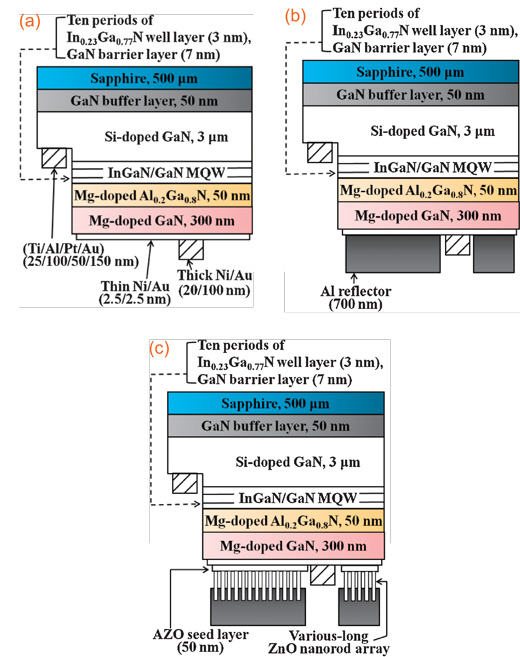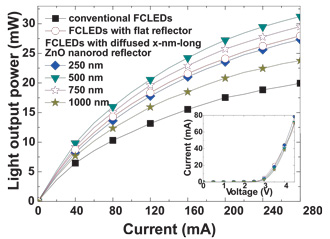- News
16 November 2012
Diffuse reflection through zinc oxide nanorods boosts LED light extraction
Taiwan’s National Cheng Kung University has used zinc oxide nanorods and an aluminium reflector to improve light extraction from nitride semiconductor flip-chip light-emitting diodes (FCLEDs) through diffuse reflection [Ching-Ting Lee and Chia-Yin Chuang, Appl. Phys. Express, vol5, p112104, 2012].
Light extraction is a problem in nitride semiconductor LEDs because the refractive index (n) difference between gallium nitride (GaN, n ~ 2.4) and air (n ~ 1) is large, reducing the escape cone to a critical angle of around 24°. This means that a large amount of the light reaching GaN/air interfaces is reflected back into the device.
If the angle of reflection at one of the surfaces of the device can be changed to fall within the escape cone then the light may eventually emerge from the LED rather than reabsorbed into the material of the device. A number of techniques have been developed to do this such as surface texturing.
Diffuse reflection is one way of changing the reflection angle. In mirror-like ‘specular’ reflection, the light rays are reflected at an angle equal to that at incidence. Diffuse reflection gives a spread of reflection angles.
The nitride semiconductor epitaxial material for the LEDs was grown on c-plane sapphire using metal-organic chemical vapor deposition (Figure 1). In the final LED, the grown material is flipped so that the contacts made with the nitride semiconductor don’t get in the way of the light that is emitted through the sapphire substrate.

Figure 1: Schematic configuration of (a) conventional FCLEDs, (b) FCLEDs with flat reflector, and (c) FCLEDs with ZnO nanorod diffuse reflector.
The InGaN/GaN multi-quantum well (MQW) active region consisted of 10 periods with 3nm-thick In0.23Ga0.77N wells and 7nm-thick barriers. The material was annealed at 750°C for 30 minutes in nitrogen to activate the magnesium doping of the p-type layers.
A nickel mask was patterned to create 300µm x 300µm mesas through reactive ion etching down to the n-type layers for isolation of the LED devices. The n-contact metals were titanium/aluminium/platinum gold annealed at 850°C for 2 minutes in nitrogen to give an ohmic contact.
The p-contact consisted of thin nickel/gold (2.5nm/2.5nm) layers designed to spread the current across the more resistive p-contact GaN layer. Thicker layers of nickel/gold (20nm/100nm) were used for the p-electrodes. The nickel/gold layers were annealed at 500°C for 10 minutes to give an ohmic contact.
Without further processing, these devices (Figure 1a) constituted conventional flip-chip LEDs (FCLEDs). A simple way to increase light output is to deposit a 700nm aluminium reflector on the annealed nickel/gold p-contact layers (Figure 1b).
The third type of LED with an array of ZnO nanorods was produced by depositing a 50nm Al-doped ZnO layer on the nickel/gold p-contact layer as seed and then using the hydrothermal method to grow ZnO nanorods. The nanorod layer was capped with a 700nm Al layer to create a ‘Lambertian’ diffuse reflector (Figure 1c).
Different lengths of nanorod gave different amounts of diffuse reflection, with 500nm nanorods showing the strongest diffusion intensity in tests under helium-neon laser illumination at a 15° angle of incidence. If the nanorods become too long, the reflector’s performance becomes degraded by light absorption. Reflectors with too short nanorods do not have enough roughness at the Al-nanorod interface to diffuse the reflection.
 Figure 2: Light output power of conventional FCLEDs, FCLEDs with flat reflector, and FCLEDs with various diffused nanorod reflectors. Inset: current–voltage characteristics.
Figure 2: Light output power of conventional FCLEDs, FCLEDs with flat reflector, and FCLEDs with various diffused nanorod reflectors. Inset: current–voltage characteristics.
The optimal nanorod length of 500nm was confirmed in electroluminescence measurements at injection currents up to 280mA (Table 1 and Figure 2). The forward voltage at 20mA was roughly 3.51V for all devices. The light output for the optimal 500nm nanorod device was enhanced 56.6% over the conventional device at 280mA, and 11.7% over the device with flat reflector under the same injection current.
| Nanorod length | Output power |
| None | 19.94mW |
| None with flat reflector | 27.95mW |
| 250nm | 27.38mW |
| 500nm | 31.22mW |
| 750nm | 29.91mW |
| 1000nm | 24.02mW |
Table 1: Light output power at 280mA for FCLEDs with various ZnO nanorod diffuse reflectors.
Another effect of using nanorod diffuse reflectors was to give a much smoother angular distribution, particularly in the region from 60° to 120°. This phenomenon was attributed to emitted photons being scattered more uniformly to a wider angle by the combination of roughened Al metal reflector and ZnO nanorod array. Overall, the improved performance was attributed to the use of highly reflective roughened Al metal and the lower refractive index of the ZnO nanorod array.
http://apex.jsap.jp/link?APEX/5/112104
The author Mike Cooke is a freelance technology journalist who has worked in the semiconductor and advanced technology sectors since 1997.


